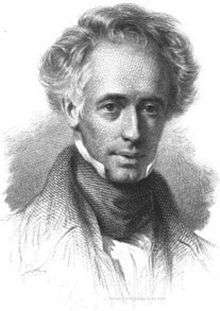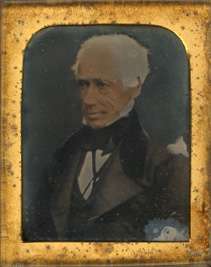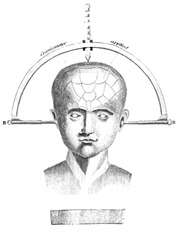George Combe
| George Combe | |
|---|---|
 George Combe, 1836 by Daniel Macnee | |
| Born |
21 October 1788 Edinburgh |
| Died |
14 August 1858 (aged 69) Moor Park, Farnham, Surrey |
| Nationality | British |
| Known for | phrenology |
| Scientific career | |
| Fields |
phrenology writer |
George Combe (21 October 1788 – 14 August 1858) was a Scottish lawyer and the leader and spokesman of the phrenological movement for more than twenty years. He founded the Edinburgh Phrenological Society in 1820 and was the author of the highly influential The Constitution of Man (1828). Combe trained in Scots law and had an Edinburgh solicitor's practice. In his later years, after a successful marriage in 1833, Combe devoted himself to international travel in the promotion of phrenology.
Early life
George Combe was born in Edinburgh, the son of George Combe, a prosperous brewer in the city, and the elder brother of Andrew Combe. After attending the High School of Edinburgh and the University of Edinburgh, Combe entered a lawyer's office in 1804; and, in 1812, he began his own practice.
The Combe family lived together in a large home at 25 Northumberland Street in the New Town until at least 1833.[1]
The Phrenological Society
In 1815, the Edinburgh Review contained an article on the system of "craniology" of Franz Joseph Gall and Johann Gaspar Spurzheim, which was denounced as "a piece of thorough quackery from beginning to end." When Spurzheim came to Edinburgh in 1816, Combe was invited to a friend's house where he watched Spurzheim dissect a human brain.[2] Impressed by this demonstration, he attended the second series of Spurzheim's lectures. Investigating the subject for himself, he became satisfied that the fundamental principles of phrenology were true—namely
| “ | that the brain is the organ of mind; that the brain is an aggregate of several parts, each subserving a distinct mental faculty; and that the size of the cerebral organ is, caeteris paribus, an index of power or energy of function. | ” |

In 1820, Combe helped to found the Phrenological Society of Edinburgh, which in 1823 began to publish a Phrenological Journal. Through his lectures and writings, Combe attracted public attention to phrenology on Continental Europe and in the United States, as well as in his native United Kingdom.[2]
Debate with Hamilton
Combe began to lecture at Edinburgh in 1822, and published a Manual called Elements of Phrenology in June 1824. He took private tuition in elocution; and contemporaries described him as clever and opinionated. Combe's discussions had an air of confidentiality and rather theatrical urgency. Converts came in, new societies sprang up, and controversies began. A second edition of the Elements, 1825, was attacked by Francis Jeffrey in the Edinburgh Review for September 1825. Combe replied in a pamphlet and in the journal. Sir William Hamilton delivered addresses to the Royal Society of Edinburgh in 1826 and 1827 attacking the phrenologists. A sharp controversy followed, including challenges to public disputes and mutual charges of misrepresentation, in which Spurzheim took part. The correspondence was published in the fourth and fifth volumes of the Phrenological Journal.[3]
Social interests: schools, prisons and asylums

In 1836, Combe stood for the chair of Logic at Edinburgh, against two other candidates, Sir William Hamilton and Isaac Taylor;[4] Hamilton won with 18 votes, against 14 for Taylor.[3] In 1838 Combe visited the United States and studied the treatment of criminals there. He initiated a programme of public education about chemistry, physiology, history and moral philosophy.
Combe sought to improve the provision of public education and he advocated a national system of non-sectarian education.[5] He helped set up a school in Edinburgh run on the principles of William Ellis, and did some teaching there himself on phrenology and physiology.[3] It was prompted by the London "Birkbeck School" opened on 17 July 1848.[6][7][8] Combe was a significant figure in his view that the state should be involved with the educational system. His ideas were supported by William Jolly, an inspector of schools, and noted by Frank Pierrepont Graves.[9]
Combe was seriously concerned about prison reform; and, with the assistance of William A. F. Browne, he opened a debate about the introduction of the humane treatment of psychiatric patients in publicly funded asylums.
Later life
John Ramsay L'Amy WS FRSE (son of James L'Amy) trained under Combe[10] at his offices at 25 Northumberland Street in Edinburgh's New Town.[11]
In 1842, Combe delivered a course of 22 lectures on phrenology in the Ruprecht Karl University of Heidelberg, and he travelled much in Europe, inquiring into the management of schools, prisons and asylums.
On retirement Combe lived in a substantial and elegant terraced townhouse, 45 Melville Street, in Edinburgh's West end.[12]
Combe was revising the 9th edition of the Constitution of Man when he died at Moor Park, Farnham in August 1858. He is buried in the Dean Cemetery in Edinburgh against the north wall of the original section.
Works
In 1817 his first essay on phrenology was published in The Scots Magazine; and a series of papers on the same subject appeared soon afterwards in the Literary and Statistical Magazine; these were collected and published in 1819 in book form as Essays on Phrenology, which in later editions became A System of Phrenology.

Combe's most popular work, The Constitution of Man, was published in 1828, and he was widely denounced as a materialist and atheist. In this book, Combe wrote: "Mental qualities are determined by the size, form and constitution of the brain; and these are transmitted by hereditary descent". ‘Combe was part of an active Edinburgh scene composed of people thinking about the nature of heredity and its possible malleability, such as Lamarck proposed. Combe himself was not a Lamarckian, but in the decades before the publication of Darwin's Origin of Species, the Constitution was probably the single most important vehicle for the dissemination of naturalistic progressivism in the English-speaking world.’[13]
He wrote Answers to the Objections Urged Against Phrenology in 1838. In 1840, he published his Moral Philosophy, and in the following year his Notes on the United States of North America.
He wrote Phrenology Applied to Painting and Sculpture in 1855. The culmination of Combe's autobiographical philosophy is contained in "On the Relation between Science and Religion", first publicly issued in 1857. Combe moved into the economic arena with his pamphlet on The Currency Question (1858). A more fully elaborated phrenological approach to political economy was later set out by William Ballantyne Hodgson.
Family
In 1833, Combe married Cecilia Siddons, a daughter of the actress Sarah Siddons, and sister of Henry Siddons, the author of the Practical Illustrations of Rhetorical Gesture and Action (1807). She brought him a fortune, as well as a happy – though childless – marriage (preceded by a phrenological check for compatibility). A few years later, he retired from work as a lawyer in comfortable circumstances.[3]
He is buried in Dean Cemetery, Edinburgh. The large but simple headstone lies against the north wall of the original cemetery, backing onto the first northern extension. Cecilia Siddons is buried with him.
References
- Combe, George. (1828). The Constitution of Man Considered in Relation to External Objects. J. Anderson jun. (reissued by Cambridge University Press, 2009; ISBN 978-1-108-00413-8)
- Combe, George. (1830). A System of Phrenology Edinburgh: J Anderson. Full Text Available at archive.org
- Combe, George. (1857). On the Relation Between Science and Religion. Maclachlan and Stewart (reissued by Cambridge University Press, 2009; ISBN 978-1-108-00451-0)
- Wright, Peter (August 2005). "George Combe—phrenologist, philosopher, psychologist (1788–1858)". Cortex. 41 (4): 447–51. doi:10.1016/s0010-9452(08)70185-0. PMID 16042021.
- Kaufman, M H (October 1995). "Circumstances surrounding the examination of the skull and brain of George Combe (1788–1858) advocate of phrenology". Proceedings of the Royal College of Physicians of Edinburgh. 25 (4): 663–74. PMID 11608956.
- Sait, J E (1976). "The Combe collection in the National Library of Scotland". The Bibliotheck. 8 (1–2): 53–4. PMID 11634646.
- De Giustino, D (1972). "Reforming the commonwealth of thieves: British phrenologists and Australia". Victorian Studies. 15: 439–61. PMID 11678098.
- Walsh, A A (July 1971). "George Combe: a portrait of a heretofore generally unknown behaviorist". Journal of the History of the Behavioural Sciences. 7 (3): 269–78. doi:10.1002/1520-6696(197107)7:3<269::AID-JHBS2300070305>3.0.CO;2-6. PMID 11609418.
Notes
- ↑ "Edinburgh Post Office annual directory, 1832-1833". National Library of Scotland. p. 39. Retrieved 2018-02-18.
- 1 2 "George Combe - Encyclopedia". www.theodora.com. Retrieved 2016-09-23.
- 1 2 3 4 Stephen 1887.
- ↑

- ↑ Charles William Bardeen (1901). A Dictionary of Educational Biography. Harvard University. C.W. Bardeen.
- ↑

- ↑ "Surgeons' Square from The Gazetteer for Scotland". Retrieved 2018-02-18.
- ↑ Archer, R. L. (Richard Lawrence) (1921). Secondary education in the nineteenth century. University of California Libraries. Cambridge University Press.
- ↑ Miller, John T. (1922). Applied character analysis in human conservation. University of California Libraries. R. G. Badger.
- ↑ Biographical Index of Former Fellows of the Royal Society of Edinburgh 1783–2002 (PDF). The Royal Society of Edinburgh. July 2006. ISBN 0-902-198-84-X.
- ↑ Edinburgh and Leith Post Office Directory 1832-33
- ↑ Edinburgh and Leith Post Office Directory 1857-8
- ↑ Jenkins, Bill (2015). "Phrenology, heredity and progress in George Combe's Constitution of Man". The British Journal for the History of Science. 48 (3): 455–473. doi:10.1017/S0007087415000278.
- Attribution



External links
| Wikimedia Commons has media related to George Combe. |